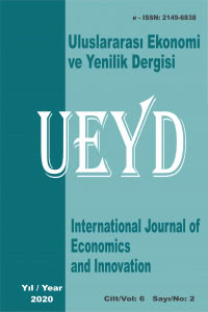Seferihisar’ın Ekonomik ve Mali Yapısı Üzerinden Sakin Şehir Uygulamalarına İlişkin Bir İnceleme
Cittaslow Hareketi’nin temelleri 1999 yılında İtalya'nın Orvieto kentinde atılmıştır. Bu hareket, küreselleşmenin getirdiği standartlaşmanın sonucu olarak hızlı ve tüketime dayalı bir hayatın egemen olduğu şehir yaşamına farklı bir alternatif olarak ortaya çıkmıştır. Bu çalışmada, öncelikle, yerel özellikleri koruyarak turizm başta olmak üzere belirli alanlarda kentsel yaşama önemli katkıları olan Sakin Şehir Hareketi tanıtılmıştır. İkinci olarak, Türkiye’nin ilk Sakin Şehri olan Seferihisar örneğinde bu hareketin şehirlere ekonomik ve mali açıdan sağladığı veya sağlayabileceği katkılar araştırılmıştır. Çalışmada; özellikle organik tarım, turizm, kadın istihdamı ve yenilebilir enerji gibi alanlarda Seferihisar’da görülen olumlu gelişmelerin, daha kapsamlı bir şekilde Türkiye’de bugün var olan ve gelecekte bu sisteme dahil olabilecek diğer Sakin Şehirlerde de yaşanabileceği sonucuna varılmıştır. Çalışmada ayrıca, devletin Sakin Şehir uygulamalarını ve bu kapsamdaki projeleri destekleyici ve düzenleyici yönde özel yasalar ve özel teşvik programları hazırlamasının önemi vurgulanmıştır.
Anahtar Kelimeler:
Sakin Şehir, Yavaş Yaşam, Seferihisar
A Review of Cittaslow Practices on the Economic and Fiscal Structure of Seferihisar
The foundations of the Cittaslow Movement were laid in 1999 in Orvieto, Italy. This movement has emerged as a different alternative to urban life, where a rapid and consumption-based life predominates as a result of the standardization brought by globalization. In this study, firstly Cittaslow Movement, which is an important contribution to urban life in particular areas, especially tourism, by preserving local characteristics, was introduced. Secondly, in the case of Seferihisar, the first Cittaslow of Turkey, the contributions that this movement provided or could provide in economic and fiscal terms were investigated. In the study; positive developments in Seferihisar especially in fields such as organic agriculture, tourism, women's employment and renewable energy have come to the conclusion that there can be more extensively in other Cittaslow cities that exist in Turkey today and can be included in this system in the future. It also emphasized the importance of the government's implementation of Cittaslow and the preparation of special legislation and special incentive programs in supportive and regulatory frameworks for projects in this context.
Keywords:
Cittaslow, Slow Life, Seferihisar,
___
- Alptürk, E. (2015), “Kayıtdışı İstihdamın Finansal ve Vergisel Boyutu”, http://kayitdisiekonomi.com/makale/detay.asp?id=33 (Erişim: 13.09.2015).
- Atlas (2015), “Cittaslow Hareketine Katılan Türkiye ve Dünya Kentleri”, Atlas Dergisi, Ek Sayı: 271, İstanbul: Doğan Ofset Yayıncılık ve Matbaacılık A.Ş.
- BİK (Basın İlan Kurumu) (2014), “Kayıtdışı Ekonomi Geriledi”, http://www.bik.gov.tr/kayit-disi-ekonomi-geriledi-haberi-75507/ (Erişim: 13.10.2015).
- BSTB (Bilim, Sanayi ve Teknoloji Bakanlığı) (2012), KOBİ’ler ve Girişimcilerin Türk Ekonomisindeki Yeri ve Önemi, https://anahtar.sanayi.gov.tr/tr/news/kobiler-ve-girisimcilerin-turk-ekonomisindeki-yeri-ve-onemi/261 (Erişim: 10.02.2017).
- Bowden, N. and Payne, James, E. (2010), “Sectoral Analysis of the Causal Relationship Between Renewable and Non-Renewable Energy Consumption and Real Output in the US.”, Energy Sources, Part B: Economics, Planning, and Policy, 5 (4), 400-408.
- Caffyn, A. (2007), “Slow Tourism”, www.tpnw.org (Erişim: 28.07.2015).
- Cittaslow Seferihisar (2015), http://cittaslowturkiye.org/cittaslow-seferihisar/ (Erişim: 12.11.2015)
- Cittaslow Türkiye (2015), http://cittaslowturkiye.org/uyelik-sureci-ve-kriterler/ (Erişim: 19.12.2015)
- Cittaslow (2017-1), http://www.cittaslow.org/sites/default/files/content/page/ files/246/cittaslow_list_october_2016.pdf, (Erişim: 10.02.2017).
- Cittaslow (2017-2), http://www.cittaslow.org/news/savsat-turkish-cittaslow-coordinating-committee-2017, (Erişim: 10.02.2017).
- ISSN: 2149-6838
- Yayın Aralığı: Yılda 2 Sayı
- Başlangıç: 2015
- Yayıncı: Seyfettin Artan
Sayıdaki Diğer Makaleler
Turist Akımları ile Döviz Kuru Oynaklığı Arasındaki İlişkinin Ampirik Yönden Analizi: ARDL Yöntemi
Türkiye’den OECD Ülkelerine Nitelikli İşgücü Göçü: Bir Panel Veri Analizi
Türkiye’de Doğrudan Yabancı Yatırımlar, Dış Ticaret ve Ekonomik Büyüme İlişkisi
Seferihisar’ın Ekonomik ve Mali Yapısı Üzerinden Sakin Şehir Uygulamalarına İlişkin Bir İnceleme
